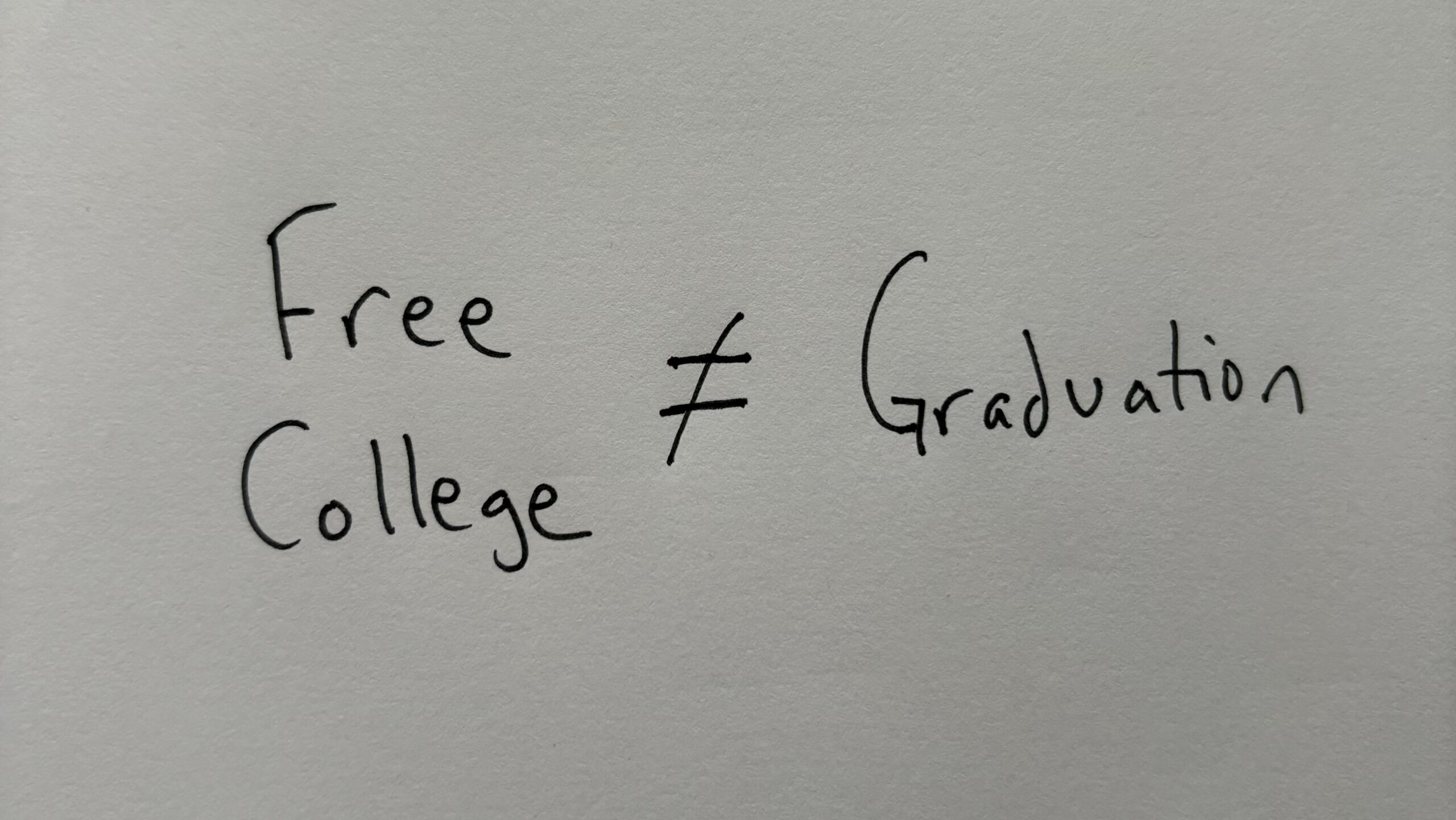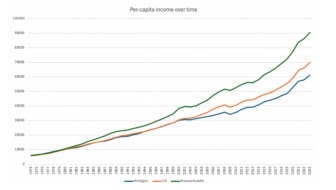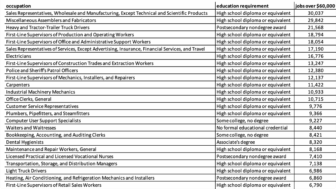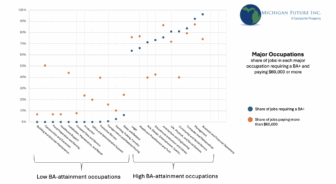Over the next several weeks, I’ll be writing a series of posts about the importance of educational attainment – both to our statewide economy and to individual economic mobility and prosperity – and how we should be designing our K-16 education system to increase the number of Michiganders who attain bachelor’s degrees.
This fourth post begins to delve into strategies for boosting educational attainment. See links to previous posts below:
Post #1: Educational attainment and economic development
Post #2: Educational attainment and economic well-being
Post #3: College completion rates
In 2017, just over 102,000 students graduated from Michigan high schools. Within a year of graduation, roughly 43,000 of those graduates (42.2% of the graduating class) enrolled at a four-year college. Roughly 30,400 (29.7% of the graduating class) enrolled at a two-year college.
Six years later, roughly 33,000 students (32% of the graduating class) had earned a four-year degree. An additional 7,500 students had earned some other sub-baccalaureate credential, either a two-year degree or a certificate. In all, roughly 40,000 young Michiganders from the graduating high school class of 2017 had any type of higher education credential six years later. An additional 8,600 students remained in school. But even if all of these students completed a credential, this would still mean that more than 25,000 graduates from the high school class of 2017 started college, but left without a credential, not to mention the more than 25,000 who never entered college at all.
It should be noted that the vast majority of students from the class of 2017 who entered college – either a two- or four-year college – had dreams of attaining a four-year degree. Obviously this is true of the students who entered a four-year college, but research suggests that 80 percent of students who enroll in a two-year college have plans of transferring to a four-year college and completing a bachelor’s degree. However, the national averages suggest roughly one-third of students who begin at a four-year college won’t finish, and just one in six of those students entering a two-year college with plans of completing a four-year degree will complete their bachelor’s degree. Based on the completion rates for the class of 2017, these figures seem to hold true for Michigan.
These low completion rates are a major problem. They mean that thousands of students in every entering cohort won’t leave school with a four-year degree, and therefore don’t get to realize the financial gains that accrue to those with a four-year degree. This problem is made that much worse when we consider that the student loan “crisis” is largely centered on those students who take out loans to attend college but fail to complete their degree.
So how do we solve this problem? How do we create an education system in which more students who pursue a college education end up leaving with a degree?
My next several posts will dive into this question, looking at how our K-12, community college, and four-year college systems ought to be structured if we are to dramatically increase the number of young people in our state who go on to complete a bachelor’s degree.
In this post, however, I’m going to explore the issue of cost, and how dealing with the cost of college is an insufficient strategy for boosting educational attainment.
The Kalamazoo Promise
As many readers are likely aware, Michigan is home to one of the most ambitious cost-focused higher-education initiatives in recent memory – the Kalamazoo Promise. Launched in 2005 and supported by the generous donations of anonymous benefactors, the Kalamazoo Promise was designed to provide a tuition-free pathway to any public community college or public four-year university in Michigan for all graduates of Kalamazoo Public Schools (KPS). Surely part of the motivation behind the development of the Kalamazoo Promise is the belief that the high cost of college is a primary obstacle preventing more low-income students and students of color from attaining college degrees and that, once removed, college attainment rates for KPS students would dramatically increase.
However, data from the first seven classes of KPS graduates eligible for the scholarship present a more complicated story. In the first seven “promise” classes, 70% of white women and 63% of white men went on to secure a postsecondary credential within 10 years of graduation, as did just 42% of Black women and 26% of Black men. Forty-eight percent of white graduates went on to complete a bachelor’s degree within 10 years, as did just 19% of Black students. And 51% of middle-class or affluent students completed a bachelor’s degree within 10 years, as did just 20% of low-income students.
Despite the removal of what many think of as the central barrier to college completion, completion rates for KPS students – and particularly for non-affluent students and students of color – remained low. There remained large attainment gaps between white and Black students and affluent and low-income students. And even among middle-class and affluent students, only half went on to complete a bachelor’s degree within 10 years of high school graduation.
To be sure, the large reduction or elimination of tuition costs for KPS students (the size of the subsidy students receive depends on how long they attend KPS schools: for example, students who attend KPS from kindergarten through 12th grade receive a 100% tuition subsidy, while those who attend KPS starting in the 9th grade through the 12th grade receive a 65% subsidy) made a positive impact. A careful study by researchers at the Upjohn Institute for Employment Research found that the Promise increased the chance of KPS students enrolling in a four-year college by 23 percent and increased the percentage of KPS students earning a postsecondary credential six years after high school graduation by 10 percentage points, from 36 percent to 46 percent.
It’s just that, given the scale of the intervention, it is safe to assume that many observers might have expected even stronger results. And it begs the question: why doesn’t the elimination or dramatic reduction of the cost barrier have a larger impact on college completion rates?
It turns out that for all the attention focused on financial aid to individual students – be it federal Pell grants, state-based “free college” programs, or even more ambitious efforts like the Kalamazoo Promise – there is very little evidence to show these programs meaningfully impact completion rates. They are clearly helpful in expanding access, and reducing the perceived cost barrier that may prevent some students from pursuing college in the first place. It’s just that there is not a lot of data that shows that individual aid to students increases completion rates.
The removal or easing of the burden of tuition is surely a positive intervention and could indeed allow students to take on behaviors that would increase the odds of persistence and completion. However, if a student needs additional supports – if they’re struggling in their coursework, or they don’t know what classes to take, or they feel like they don’t belong in college – tuition assistance is of no help. Rather, the student needs support from the university – they need a higher quality education.
Not all free college programs are created equal
It should also be noted that depending on how free college programs are structured, they can negatively impact bachelor’s degree completion rates. If, for example, a free college program covered tuition at community colleges but not at four-year colleges, students who could gain admission to a four-year college could be incentivized to instead start at a two-year college, thinking that they will get some credits under their belt on the cheap. The problem with this is that student outcomes are much worse at community colleges than they are at four-year colleges. This is the case for a whole host of reasons, but largely has to do with the amount of resources institutions can devote to student supports.
A few years back, a remarkable set of studies looked at the long-term educational attainment of thousands of students who lived in states where the public university system required students to achieve an SAT score above a certain cutoff in order to gain admission to the least selective four-year institution. This arrangement presented researchers with a natural experiment. Students who scored, for example, an 840 on their SAT were able to gain admission to a four-year institution, but students who just missed that cut off – and maybe scored an 830 – were not. By taking these two groups – those that just scored just above the threshold and those that scored just below – and matching them for a range of other observable characteristics, researchers were able to follow the paths of nearly identical students who were rather arbitrarily given access to either a two-year college or four-year college pathway. One of these studies found that students in Georgia who scored just above the cutoff were 77 percent more likely than a comparison group to attend a four-year institution. Of those who scored just above the cutoff and enrolled in a four-year college, 50 percent went on to complete a bachelor’s degree within six years, while only 17 percent of students in the control group did. The effect was even greater for low-income students, considering that only 2 percent of the control group went on to complete a bachelor’s degree within six years, while half of marginal students that attended a four-year institution went on to complete a bachelor’s degree in six years. The moral of the story? Be really careful how you structure free college programs.
Cost is important. The quality of education is more important.
While individual financial aid can be an important piece of the puzzle, it will not meaningfully improve completion rates if we don’t also improve the quality of the education experienced by students. This is where we will go next in this series – exploring the elements of a high-quality education system that are needed at the K-12, community college, and four-year college levels if we are to meaningfully increase educational attainment in Michigan.







